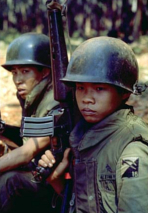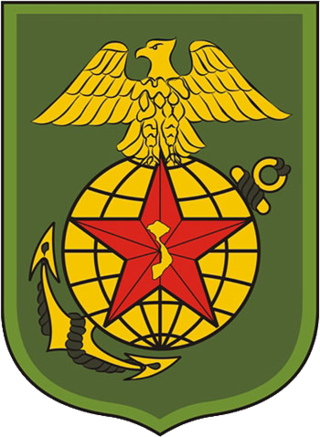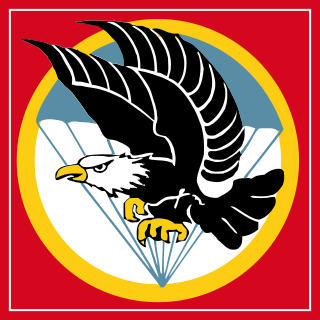
The 82nd Airborne Division is an airborne infantry division of the United States Army specializing in parachute assault operations into hostile areas with a U.S. Department of Defense mandate to be "on-call to fight any time, anywhere" at "the knife's edge of technology and readiness." Primarily based at Fort Liberty, North Carolina, the 82nd Airborne Division is part of the XVIII Airborne Corps. The 82nd Airborne Division is the U.S. Army's most strategically mobile division.

The Army of the Republic of Vietnam composed the ground forces of the South Vietnamese military from its inception in 1955 to the Fall of Saigon in April 1975. At the ARVN's peak, an estimated 1 in 9 citizens of South Vietnam were enlisted,composed of Regular Forces and the more voluntary Regional Forces and the Popular Force militias. It is estimated to have suffered 1,394,000 casualties during the Vietnam War.

The Americal Division was an infantry division of the United States Army during World War II and the Vietnam War.
The Winterfilm Collective consisted of Fred Aronow (cinematographer), Nancy Baker (editor), Joe Bangert, Rhetta Barron (editor), Robert Fiore (cinematographer), David Gillis (cinematographer), David Grubin, Jeff Holstein (cinematographer), Barbara Jarvis (editor), Algis "Al" Kaupas, Barbara Kopple, Mark Lenix, Michael Lesser (cinematographer), Nancy Miller, Lee Osborne, Lucy Massie Phenix (editor), Roger Phenix, Benay Rubenstein (editor), Rusty Sachs, and Michael Weill (editor).
The "Winter Soldier Investigation" was a media event sponsored by the Vietnam Veterans Against the War (VVAW) from January 31, 1971, to February 2, 1971. It was intended to publicize war crimes and atrocities by the United States Armed Forces and their allies in the Vietnam War. The VVAW challenged the morality and conduct of the war by showing the direct relationship between military policies and war crimes in Vietnam. The three-day gathering of 109 veterans and 16 civilians took place in Detroit, Michigan. Discharged servicemen from each branch of the armed forces, as well as civilian contractors, medical personnel and academics, all gave testimony about war crimes they had committed or witnessed during the years 1963–1970.

Chu Lai is a seaport, urban and industrial area in Núi Thành District, Quảng Nam Province, Vietnam. The city is served by Chu Lai International Airport. It is also the site of the Chu Lai Open Economic Zone.

The Battle of Xuân Lộc was the last major battle of the Vietnam War that took place at Xuân Lộc, Đồng Nai Province. Over a period of twelve days between 9 and 21 April 1975, the outnumbered South Vietnamese reserves attempted to stop the North Vietnamese forces from overunning the town and breaking through towards South Vietnam's capital, Saigon. The Army of the Republic of Vietnam (ARVN) committed almost all their remaining mobile forces, especially the 18th Division, under Brigadier General Lê Minh Đảo, to the defence of the strategic crossroads town of Xuân Lộc, hoping to stall the People's Army of Vietnam (PAVN) advance. The battle ended when the town of Xuân Lộc was captured by the PAVN 4th Army Corps led by Major General Hoàng Cầm.

Operation Lam Son 719 or 9th Route – Southern Laos Campaign was a limited-objective offensive campaign conducted in the southeastern portion of the Kingdom of Laos. The campaign was carried out by the armed forces of South Vietnam between 8 February and 25 March 1971, during the Vietnam War. The United States provided logistical, aerial and artillery support for the operation, but its ground forces were prohibited by law from entering Laotian territory. The objective of the campaign was the disruption of a possible future offensive by the People's Army of Vietnam (PAVN), whose logistical system within Laos was known as the Ho Chi Minh Trail.

Operation Wheeler/Wallowa was a U.S. offensive operation during the Vietnam War, launched on 11 September 1967 as two separate operations and concluding in November 1968. Initially named as Operation Wheeler and Wallowa, this was merged in November 1967 as Wheeler/Wallowa. The operation was at first conducted by the 101st Airborne Division and 1st Cavalry Division, but it was progressively taken over by 23rd Infantry (Americal) Division.

The Battle of Kham Duc was a major battle of the Vietnam War. The event occurred in Khâm Đức, now district capital of Khâm Đức District, then in Quảng Tín Province, from 10–12 May 1968. During the Tet Offensive of 1968, the People's Army of Vietnam (PAVN) 2nd Division tried to capture Đà Nẵng, but they were defeated in the Battle of Lo Giang by elements of the U.S. 1st Marine Division and the 23rd Infantry Division. PAVN General Chu Huy Mân disengaged from the fight on the outskirts of the city, and pulled the 2nd Division into the mountains to rest, rebuild, and prepare for the next major operation. The US and allied defenders of the Special Forces camp at Khâm Đức, a small district in the north of Quảng Tín, were chosen as the next target for the 2nd Division. Although the Special Forces camp had never been an obstacle to the constant infiltration of PAVN troops around it, the North Vietnamese hoped to attract major US reinforcements away from the lowland populated areas, kill or capture them and film the battle, presumably to make it look like a US Điện Biên Phủ on the eve of the 1st Paris peace conference.
Camp Baharia, also known as Dreamland or FOB Volturno, was a U.S. military installation that was just outside the city of Fallujah, Iraq. It was the smaller of two major U.S. military bases maintained just outside the Fallujah city limits, during the Iraq War.

The Republic of Vietnam Marine Division was part of the armed forces of South Vietnam. It was established by Ngo Dinh Diem in 1954 when he was Prime Minister of the State of Vietnam, which became the Republic of Vietnam in 1955. The longest-serving commander was Lieutenant General Le Nguyen Khang. In 1969, the VNMC had a strength of 9,300, 15,000 by 1973, and 20,000 by 1975.
The National Committee for a Citizens Commission of Inquiry on U.S. war crimes in Vietnam was founded in New York by Ralph Schoenman in November 1969 to document American atrocities throughout Indochina. The formation of the organization was prompted by the disclosure of the My Lai Massacre on November 12, 1969, by Seymour Hersh, writing for the New York Times. The group was the first to bring to public attention the testimony of American Vietnam War veterans who had witnessed or participated in atrocities.

The 1st Division of the Army of the Republic of Vietnam (ARVN)—the army of the nation state of South Vietnam that existed from 1955 to 1975—was part of the I Corps that oversaw the northernmost region of South Vietnam, the centre of Vietnam.

The Vietnamese Airborne Division or VNAD was one of the earliest components of the Republic of Vietnam Military Forces. The Vietnamese Airborne Division began as companies organized in 1948, prior to any agreement over armed forces in Vietnam. After the partition of Vietnam, it became a part of the Army of the Republic of Vietnam. This division had its distinct origins in French-trained paratrooper battalions, with predecessor battalions participating in major battles including Dien Bien Phu and retained distinct uniforms and regalia. With the formation of an independent republic, the colonial paratroopers were dissolved, however regalia and aesthetics alongside the nickname "Bawouans" would be retained.

The inauguration of Richard Nixon in January led to a reevaluation of the U.S. role in the war. U.S. forces peaked at 543,000 in April. U.S. military strategy remained relatively unchanged from the offensive strategy of 1968 until the Battle of Hamburger Hill in May which led to a change a more reactive approach. The U.S. and South Vietnam agreed on a policy of Vietnamization with South Vietnamese forces being expanded and equipped to take over more of the ground combat from the departing Americans which began to withdraw in late June without any reciprocal commitment by the North Vietnamese. The morale of U.S. ground forces began to fray with increasing racial tensions and the first instances of fragging and combat refusal. The antiwar movement in the U.S. continued to grow and public opinion turned increasingly antiwar when the Mỹ Lai massacre was revealed in November.

The Hue–Da Nang Campaign was a series of military actions conducted by the People's Army of Vietnam (PAVN) against the Army of the Republic of Vietnam (ARVN) during the Vietnam War, also known in Vietnam as the American War. The campaign was centred on the cities of Huế and Da Nang, with secondary fronts in the provinces of Quảng Trị and Quảng Ngãi. The campaign began on March 5 and concluded on April 2, 1975.

Task Force Oregon, was a United States Army division-sized unit composed of 3 separate infantry brigades, active in Quảng Ngãi and Quảng Tín Provinces, South Vietnam from April to September 1967 when it was redesignated the 23rd Infantry Division (Americal).

The Battle of the Mỹ Chánh Line took place from 5 May to 26 June 1972 during the People’s Army of Vietnam (PAVN)'s Easter Offensive of the Vietnam war. South Vietnamese forces, principally the Marine Division, with extensive fire and logistics support from United States forces, succeeded in stopping the PAVN advance northwest of Huế and launched a series of spoiling attacks against PAVN units. The successful defense allowed South Vietnamese forces to build up strength and then establish jumping off positions for their counteroffensive to recapture Quảng Trị Province.















